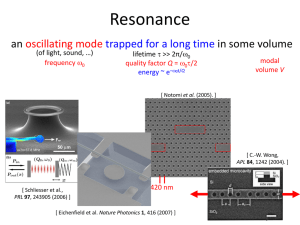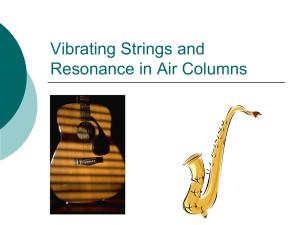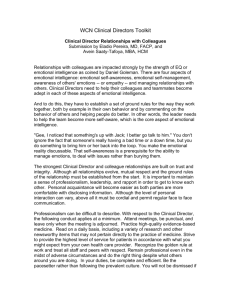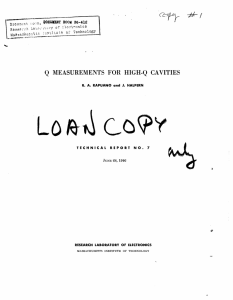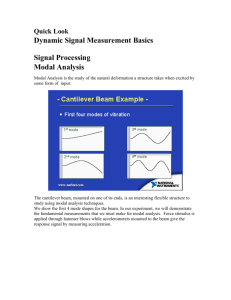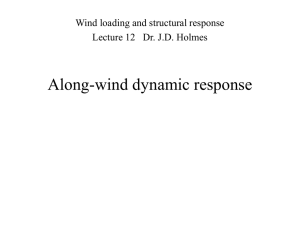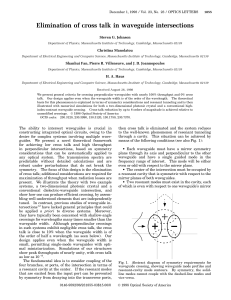Resonance Why Resonance? 5/3/12
advertisement
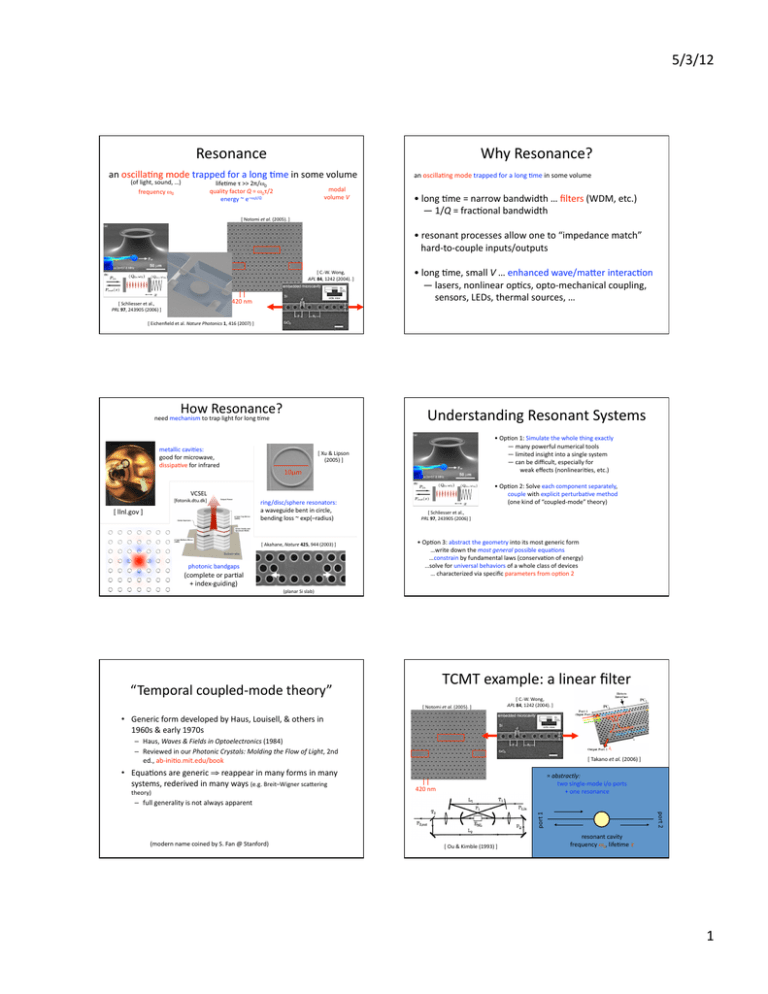
5/3/12 Resonance Why Resonance? an oscilla:ng mode trapped for a long :me in some volume (of light, sound, …) frequency ω0 life:me τ >> 2π/ω0 quality factor Q = ω0τ/2 energy ~ e–ω0t/Q modal volume V [ Notomi et al. (2005). ] an oscilla:ng mode trapped for a long :me in some volume • long :me = narrow bandwidth … filters (WDM, etc.) — 1/Q = frac:onal bandwidth • resonant processes allow one to “impedance match” hard‐to‐couple inputs/outputs [ C.‐W. Wong, APL 84, 1242 (2004). ] 420 nm [ Schliesser et al., PRL 97, 243905 (2006) ] • long :me, small V … enhanced wave/ma^er interac:on — lasers, nonlinear op:cs, opto‐mechanical coupling, sensors, LEDs, thermal sources, … [ Eichenfield et al. Nature Photonics 1, 416 (2007) ] How Resonance? Understanding Resonant Systems need mechanism to trap light for long :me metallic cavi:es: good for microwave, dissipa:ve for infrared • Op:on 1: Simulate the whole thing exactly — many powerful numerical tools — limited insight into a single system — can be difficult, especially for weak effects (nonlineari:es, etc.) [ Xu & Lipson (2005) ] 10µm • Op:on 2: Solve each component separately, couple with explicit perturba:ve method (one kind of “coupled‐mode” theory) VCSEL [fotonik.dtu.dk] [ llnl.gov ] ring/disc/sphere resonators: a waveguide bent in circle, bending loss ~ exp(–radius) [ Akahane, Nature 425, 944 (2003) ] photonic bandgaps (complete or par:al + index‐guiding) [ Schliesser et al., PRL 97, 243905 (2006) ] • Op:on 3: abstract the geometry into its most generic form …write down the most general possible equa:ons …constrain by fundamental laws (conserva:on of energy) …solve for universal behaviors of a whole class of devices … characterized via specific parameters from op:on 2 (planar Si slab) TCMT example: a linear filter “Temporal coupled‐mode theory” [ Notomi et al. (2005). ] [ C.‐W. Wong, APL 84, 1242 (2004). ] • Generic form developed by Haus, Louisell, & others in 1960s & early 1970s – Haus, Waves & Fields in Optoelectronics (1984) – Reviewed in our Photonic Crystals: Molding the Flow of Light, 2nd ed., ab‐ini:o.mit.edu/book • Equa:ons are generic ⇒ reappear in many forms in many systems, rederived in many ways (e.g. Breit–Wigner sca^ering theory) [ Takano et al. (2006) ] = abstractly: two single‐mode i/o ports + one resonance 420 nm (modern name coined by S. Fan @ Stanford) [ Ou & Kimble (1993) ] port 2 port 1 – full generality is not always apparent resonant cavity frequency ω0, life:me τ 1 5/3/12 Temporal Coupled‐Mode Theory for a linear filter s1+ s1– input a resonant cavity frequency ω0, life:me τ da 2 2 = −iω 0 a − a + s1+ dt τ τ s1− = −s1+ + 2 2 a, s2− = a τ τ output s2– Temporal Coupled‐Mode Theory for a linear filter s1+ s1– input a resonant cavity frequency ω0, life:me τ |s|2 = power |a|2 = energy assumes only: • exponen:al decay (strong confinement) • linearity • conserva:on of energy can be • :me‐reversal symmetry relaxed output s2– 1 transmission T | T = Lorentzian filter | = | s2– 2 / | s1+ 2 = ω0 Resonant Filter Example |s|2 = flux |a|2 = energy 4 τ2 (ω − ω 0 )2 + ω 4 τ2 Some interes:ng resonant transmission processes Lorentzian peak, as predicted. An apparent miracle: input power Resonant LED emission luminus.com ~ 100% transmission at the resonant frequency output power ~ 40% eff. cavity decays to input/output with equal rates ⇒ At resonance, reflected wave destruc:vely interferes with backwards‐decay from cavity & the two exactly cancel. Wireless resonant power transfer [ M. Soljacic, MIT (2007) ] witricity.com (narrow‐band) resonant absorp:on in a thin‐film photovoltaic [ e.g. Ghebrebrhan (2009) ] Wide‐angle Spli^ers [ S. Fan et al., J. Opt. Soc. Am. B 18, 162 (2001) ] Waveguide Crossings [ S. G. Johnson et al., Opt. LeN. 23, 1855 (1998) ] 2 5/3/12 Another interes:ng example: Channel‐Drop Filters Waveguide Crossings waveguide 1 Perfect channel‐dropping if: Two resonant modes with: • even and odd symmetry • equal frequency (degenerate) • equal decay rates Coupler waveguide 2 (mirror plane) empty 3x3 5x5 1x1 [ S. Fan et al., Phys. Rev. LeN. 80, 960 (1998) ] More than one Q… Dimensionless Losses: Q Q = ω0τ / 2 A simple model device (filters, bends, …): quality factor Q = # op:cal periods for energy to decay by exp(–2π) losses (radia:on/absorp:on) Qr energy ~ exp(–ω0t/Q) = exp(–2t/τ) Qw in frequency domain: 1/Q = bandwidth 1 from temporal coupled‐mode theory: 1 T = Lorentzian filter 1 2 = Q ω 0τ FWHM ω0 ω 4 τ2 = (ω − ω 0 )2 + 42 τ …quality factor Q Nonlineari:es + Microcavi:es? weak effects ∆n < 1% very intense fields & sensi:ve to small changes A simple idea: for the same input power, nonlinear effects are stronger in a microcavity Q =1 +1 Qr Qw We want: Qr >> Qw TCMT ⇒ 1 – transmission ~ 2Q / Qr Q = life:me/period = frequency/bandwidth worst case: high‐Q (narrow‐band) cavi:es Nonlinear Op:cs Kerr nonlineari:es χ(3): (polarizaUon ~ E3) • Self‐Phase Modula:on (SPM) = change in refrac:ve index(ω) ~ |E(ω)|2 • Cross‐Phase Modula:on (XPM) = change in refrac:ve index(ω) ~ |E(ω 2) |2 • Third‐Harmonic Genera:on (THG) & down‐conversion (FWM) = ω → 3ω, and back • etc… ω ω ω That’s not all! nonlineari:es + microcavi:es = qualitaUvely new phenomena 3ω ω’s ω ω Second‐order nonlineari:es χ(2): (polarizaUon ~ E2) • Second‐Harmonic Genera:on (SHG) & down‐conversion = ω → 2ω, and back • Difference‐Frequency Genera:on (DFG) = ω1, ω2 → ω1-ω2 • etc… 3 5/3/12 A Simple Linear Filter Nonlineari:es + Microcavi:es? weak effects ∆n < 1% very intense fields & sensi:ve to small changes in out A simple idea: for the same input power, nonlinear effects are stronger in a microcavity Linear response: Lorenzian Transmisson That’s not all! nonlineari:es + microcavi:es = qualitaUvely new phenomena let’s start with a well‐known example from 1970’s… Op:cal Bistability Filter + Kerr Nonlinearity? [ Felber and Marburger., Appl. Phys. LeN. 28, 731 (1978). ] Logic gates, switching, recUfiers, amplifiers, isolators, … in out Linear response: Lorenzian Transmisson stable Kerr nonlinearity: ∆n ~ |E|2 shiƒed peak? stable unstable Bistable (hysteresis) response (& even mul:stable for mul:mode cavity) + nonlinear index shiƒ = ω shiƒ TCMT for Bistability [ Soljacic et al., PRE Rapid. Comm. 66, 055601 (2002). ] Power threshold ~ V/Q2 (in cavity with V ~ (λ/2)3, for Si and telecom bandwidth power ~ mW) TCMT + Perturba:on Theory [ Soljacic et al., PRE Rapid. Comm. 66, 055601 (2002). ] input s1+ a s2– resonant cavity frequency ω0, life:me τ, SPM coefficient α ~ χ(3) (from perturba:on theory) da 2 2 2 = −i(ω 0 − α a )a − a + s1+ dt τ τ 2 2 s1− = −s1+ + a, s2 − = a τ τ output SPM = small change in refrac:ve index … evaluate ∆ω by 1st‐order perturba:on theory |s|2 = power |a|2 = energy gives cubic equa:on for transmission … bistable curve ⇒ all relevant parameters (ω, τ or Q, α) can be computed from the resonant mode of the linear system 4 5/3/12 Accuracy of Coupled‐Mode Theory Op:cal Bistability in Prac:ce [ Soljacic et al., PRE Rapid. Comm. 66, 055601 (2002). ] [ Notomi et al. (2005). ] [ Xu & Lipson, 2005 ] ly:cal semi‐ana 10µm numerical 420 nm Q ~ 30,000 V ~ 10 op:mum Power threshold ~ 40 µW Q ~ 10,000 V ~ 300 op:mum Power threshold ~ 10 mW Experimental Bistable Switch [ Notomi et al., Opt. Express 13 (7), 2678 (2005). ] Silicon‐on‐insulator 420 nm Q ~ 30,000 Power threshold ~ 40 µW Switching energy ~ 4 pJ 5
